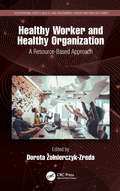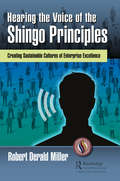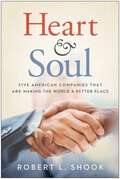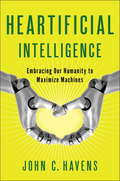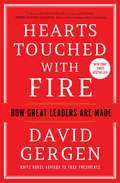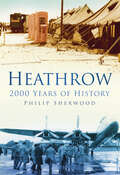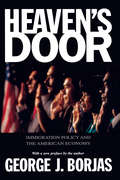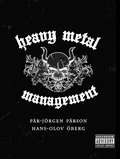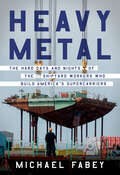- Table View
- List View
Healthy Worker and Healthy Organization: A Resource-Based Approach (Occupational Safety, Health, and Ergonomics)
by Dorota Żołnierczyk-ZredaThis book presents research on the determinants of workers’ health (physical and mental well-being) and the organization’s health (performance and culture). It addresses the impact of psychosocial working conditions on workers’ well-being, and their performance, productivity, innovation, and morale at work. Discusses how to manage workers to enable them to be engaged and creative Raises employee awareness on how to maintain good physical and mental health at work Covers how to work beyond retirement age Presents how to design a work environment that prevents counterproductive behaviors Covers work–life balance and how it can affect work This book is aimed at professionals, postgraduate students, scientists, and practitioners in the fields of work and health psychology, management, occupational health and safety, and human resource management.
Healthy at Work
by Sebastian Fischer Markus Wiencke Mirella CacaceThis book aims at exploring the link between corporate and organizational culture, public and private policy, leadership and managerial skills or attitudes, and the successful implementation of work-related healthcare in Europe. Therefore it brings together a wide range of empirical and theoretical contributions from occupational health, management, psychology, economics, and (organizational) sociology to address the question of how to sustainably promote occupational health. Such important questions are answered as: What aspects of a corporate culture can be associated with health issues? How does leadership style affect the health of employees? How are health-related decisions in the workplace affected by the political environment? To what extent are interventions influenced by corporate culture, leadership and public policy? How can we make such interventions sustainable?
Healthymagination at GE Healthcare Systems
by V. Kasturi Rangan Vineet KumarJeff Immelt, the CEO of GE, introduced a new innovation strategy named "healthymagination" in Spring 2009. With cost, quality, and access as its three pillars, healthymagination ensures a strong focus for new product introduction efforts all around GE. But will this focus enable GE to achieve and maintain market leadership across a healthcare market that is being buffeted by strong currents, including cost pressures, changes in chronic disease patterns, and rationalization of buyer behavior? Moreover, healthcare spending is also increasing in emerging economies, which could provide a strong growth engine for the future. Tom Gentile, the CEO of GE Healthcare Systems (GEHS), a key player in the Medical Imaging market, wonders how the innovation strategy might respond to these changes. GE has historically been a technology leader, selling the most advanced equipment to a variety of medical establishments. Will a complete shift to healthymagination allow GE to demonstrate strong organic growth through innovation, as Immelt had charged executives at GE?
Hearing the Voice of the Shingo Principles: Creating Sustainable Cultures of Enterprise Excellence
by Robert Derald MillerFor more than 50 years, organizations of all types have struggled to achieve lasting benefits from the many tools and programs associated with various continuous-improvement initiatives. In fact, the notion of "continuous" improvement is largely a misnomer -- for many organizations, continuous improvement has been anything but continuous. Responding to this challenge, Hearing the Voice of the Shingo Principles chronicles key insights that went into development of the Shingo Model for Operational Excellence at Utah State University. While responsible for the Shingo Prize at USU, the author observed that even recipients -- theoretically, the best of the best -- were experiencing this same up-and-down phenomenon. It was as though many of these organizations were reviewed on their very best days but then started declining from that point forward. To build long-term credibility of the Shingo Prize, the author and his team had to understand what was causing such wide variation in results and make certain they were only recognizing those organizations that could demonstrate sustainability of improvements over the long term. They found that sustainability depended less on application of the tools for improvement than on embedding principles deep into the culture of the organization from top to bottom and side to side. This book helps leaders understand their role in building sustainable cultures of enterprise excellence – That is, how to keep the entire enterprise focused on guiding principles that will change beliefs, behaviors, and the overall mindset. In addition, managers will learn how to align systems with principles so that they drive ideal, principle-based behaviors – the goal is for every leader to realign their values with the voice of principles and become an example so that every associate becomes self-motivated to continuously improve every aspect for which they are accountable.
Heart & Sold
by Valerie FitzgeraldHeart and Sold is an insightful journey through the emotional and tangible challenges of regaining one's personal power while building and maintaining a successful business -- regardless of the country's economic situation. Valerie Fitzgerald, one of the country's leading real estate agents, candidly recounts her personal journey from unemployed single parent to entrepreneur, philanthropist, and renowned corporate executive. From beginners just getting started in residential real estate to seasoned agents -- or anyone in business looking to take their game to the next level -- this step-by-step guide teaches readers the art of selling. With her personal touch, Fitzgerald shows readers how to manage clients with style, choose the right company and the best mentor, establish a stellar reputation in their field, develop a daily schedule for running a home office, and maintain a successful attitude every day. With all of her tools at their fingertips, readers will also soon be shooting for the stars. Heart and Sold shares the mind-set of a respected businesswoman who gracefully balances the demands of an empire with the intimacy of her family, and is a model for working and living that can be applied to any desire or discipline.
Heart & Soul: Five American Companies That Are Making the World A Better Place
by Robert L. ShookIn Heart & Soul, Shook takes readers on heartwarming journeys through some of America's most successful companies: Mary Kay (Dallas), whose primary focus has always been to be a vehicle for women's success and independence in a world that often supports neither; the company now has more than 2 million women working toward their dreams in 37 countries DaVita (Los Angeles/Denver), dedicated to becoming the world's best dialysis company. America's number-one provider of dialysis treatment, DaVita treats its patients and employees like family members. InRETURN (Cincinnati), a company that intentionally employs those with brain injuries and other neurological challenges World Wide Technology (St.Louis), the largest African-American–owned business in the nation, which thrives on biblical principles of fairness and caring Starkey Laboratories (St.Paul/Minneapolis), whose employees travel to remote places to provide more than 50,000 hearing aids to the poor To the employees of these companies, success is measured by the good they accomplish in the world. However, profiting and caring aren't mutually exclusive—these companies demonstrate how any company of any size can do both.
Heart of Danger (Why Leading Change is Fraught with Risk)
by Marty Linsky Ronald A. HeifetzThe single most common source of leadership failure--in politics, community life, business, or the nonprofit sector--is that people in leadership positions treat adaptive challenges like technical problems. What many leaders don't realize, however, is the danger they put themselves in by simply attempting to effect change. People by nature resist change, especially if it involves loss or uncertainty. The leader's challenge is to help people adapt to, and ultimately thrive in, evolving circumstances, and to "stay alive" in the process. This chapter looks at that source of leadership failure. This chapter was originally published as Chapter 1 of "Leadership on the Line."
Heart of Entrepreneurship
by Howard H. Stevenson David E. GumpertEntrepreneurship is a trait that is confined neither to certain types of individuals nor to organizations. A society can do much to stimulate or inhibit the development of entrepreneurship. Government policy decisions in recent years to lower the capital gains tax and deregulate certain industries have been instrumental in encouraging establishing new businesses. College and university business programs are also instrumental in stimulation. But it's up to individual organizations to foster conditions that allow entrepreneurship to flourish.
Heart, Smarts, Guts, and Luck
by Tsun-Yan Hsieh Richard J. Harrington Anthony K. TjanWhat's your entrepreneurial profile?Do you have what it takes to build a great business?In this book, three prominent business leaders and entrepreneurs-now venture capitalists and CEO advisers-share the qualities that surface again and again in those who successfully achieve their goals. The common traits? Heart, smarts, guts, and luck.After interviewing and researching hundreds of business-builders across the globe, the authors found that every one of them-from young founder to seasoned CEO-holds a combination of these four attributes. Indeed each of us tends to be biased toward one of these traits in our decision-making, and figuring out which trait drives you will lead to greater self-awareness and likelihood of success in starting and growing a business.So are you: Heart-dominant, like renowned chef Alice Waters or Starbucks's Howard Schultz? Smarts-dominant, like Jeff Bezos of Amazon or legendary investor Warren Buffett? Guts-dominant, like Nelson Mandela or Virgin's Richard Branson? Or are you most defined by the luck trait, like Tony Hsieh of Zappos (and a surprisingly high proportion of other successful entrepreneurs)?Heart, Smarts, Guts, and Luck includes the first Entrepreneurial Aptitude Test (E.A.T), a simple tool to help determine your specific profile.Though no single archetype for entrepreneurial success exists, this book will help you understand which traits to "dial up" or "dial down" to realize your full potential, and when these traits are most and least helpful (or even detrimental) during critical points of a company lifecycle. Not only will you know how to build a better business faster, you'll also take your natural leadership style to the next level.
Heartificial Intelligence
by John HavensAs we program machines to be more like humans, how will they know what we value, if we don't know ourselves?The notion of robots gaining consciousness is beginning to become a reality, but the future of human happiness is dependent on our ability to teach machines what we value the most today. Featuring pragmatic solutions drawing on economics, emerging technologies, and positive psychology, Heartificial Intelligence provides a road map to help readers embrace the present and better define their future. Using fictional vignettes to help readers relate to larger concepts, this book paints a vivid portrait of how our lives might look in either a dystopia of robot dominance or a utopia where we use technology to enhance our natural abilities and evolve into a long-lived, super-intelligent, and caring species.ta that can be mined to reveal not just our buying habits and patterns, but how these patterns are impacted by our mood, the time of year, our location, and our interests?As Havens points out in H(app)inomics, the future needn't look so grim. Indeed, if we can wrest control of our personal data from corporations and use it to better understand ourselves, Havens argues, then we can combat this looming future and make love of life our most important personal economy.
Heartport, Inc.
by Gary P. Pisano Shoshana DobrowHeartport, an entrepreneurial medical device maker, has introduced several innovative systems for conducting less-invasive cardiac surgery. Despite initially high expectations, the company has struggled to get its technology adopted by cardiac surgeons. The company's newest CEO, the third in less than four years, must figure out how to turn around the fledgling company. This case describes Heartport's method of performing minimally invasive cardiac surgery as well as rival techniques for treating cardiovascular disease. Describes the evolution of the company, its product strategy, and its fortunes over the period 1991-99.
Hearts Touched with Fire: How Great Leaders are Made
by David GergenA powerful guide to the art of leadership from David Gergen—former White House adviser to four US presidents, CNN analyst, and founder of the Harvard Center for Public Leadership. <p><p>As nations careen from one crisis to the next, there is a growing cry for fresh leadership. Those in charge have repeatedly fallen short, and trust in institutions has plummeted. So, what does great leadership look like? And how are great leaders made? <p><p>David Gergen, a leader in the public arena for more than half a century, draws from his experiences as a White House adviser to four presidents, his decades as a trusted voice on national issues, and years of teaching and mentoring young people to offer a stirring playbook for the next generation of change-makers. To uncover the fundamental elements of effective leadership, Gergen traces the journeys of iconic leaders past and present, from pathbreakers like Ruth Bader Ginsburg, John Lewis, John McCain, and Harvey Milk to historic icons like Lincoln, John F. Kennedy, Winston Churchill, and Eleanor and Franklin Roosevelt, to contemporary game changers like Greta Thunberg, the Parkland students, and the Black Lives Matter movement. <p><p>Leadership is a journey that starts from within, Gergen writes. A leader must become self-aware and then achieve self-mastery. You cannot lead others until you can lead yourself. As you start to leap into the world, you begin your outer journey, overcoming setbacks, persuading others, empowering them, and navigating crises—armed a sense of history, humor, passion, and purpose. By linking lessons of the past with the ever-changing practice of leadership today, Gergen reveals the time-tested secrets of dynamic leadership. <p><p>An indispensable manual, Hearts Touched With Fire distills experience and wisdom of the past into an invaluable guide for leaders of our future. <p> <b>New York Times Bestseller</b>
Hearts on Fire: Stories of Today's Visionaries Igniting Idealism into Action
by Bill Clinton Peter W. Cookson Jill IscolINSPIRING STORIES OF FOURTEEN VISIONARIES WHO MADE A DIFFERENCE IN THE WORLD--AND A BOLD CALL TO ACTION TO MOTIVATE THE NEXT GENERATION OF LEADERS There's Amy Lehman, a gutsy single mother who is building a floating health clinic on Lake Tanganyika; Jimmie Briggs, a journalist campaigning to stop violence against girls and women; and Jacob Lief, a young American who founded a school for street children in South Africa. You will discover how Josh Nesbit, Isaac Holeman, and Nadim Mahmud are connecting rural patients to hospitals using cellphone technology, how Susana De Anda is bringing fresh water to the migrant workers in California's San Joaquin Valley, and how Andeisha Farid is establishing, in the face of war, orphanages for Afghanistan's child victims of war and poverty. These are just some of the stories that will inspire you. Visionaries don't wait for others to take action. They step out. They are brave. They walk the walk. And they connect with others in deep and real ways. Jill Iscol's message is that everyone has the talent and compassion to make the world a better place. Hearts on Fire is a call to action for all of us.Praise for Hearts on Fire "Attention must be paid to these lives and these stories. In Jill Iscol's capable hands, their stories offer us hope--just when we need it."--Brian Williams, NBC News "What inspiring stories of people who have made meaningful lives through service and sacrifice--one person at a time. These are our world leaders!"--Richard Gere "Hearts on Fire is one of the most inspiring books I've read."--Tina Brown, editor-in-chief, The Daily Beast and Newsweek "Clear and compelling . . . I know you will be inspired by the visionaries in Hearts on Fire."--President Bill Clinton "A powerful call to action for each of us to marry passion with purpose and act boldly in the quest for a more just and sustainable world."--Cheryl Dorsey, president of Echoing Green "Powerful and eloquent, Hearts on Fire is a passionate and infectious invitation to get involved and help make the world a better place."--Henry Louis Gates Jr., Alphonse Fletcher University Professor at Harvard University "A beautifully appointed treasure box filled with inspiration and possibility. You cannot read this book without wanting to do more."--Jacqueline Novogratz, founder and CEO of Acumen Fund "A desperately needed antidote for those discouraged by the dysfunctional politics that have left so many on our planet vulnerable and voiceless."--Billy Shore, founder and executive director of Share Our Strength "Hearts on Fire reminds us that we need to dream again, inspire again, and act again."--Wes Moore, New York Times bestselling author of The Other Wes Moore "Vivid, down-to-earth, and well-told, Hearts on Fire will comfort and inspire anybody trying to do a little bit to make this world a more connected and compassionate place."--Ethan Nichtern, founder of The InterDependence Project, and author of One City: A Declaration of Interdependence
Heartselling: The Seven Magnets to Attract Customers
by Alexander ChristianiHeartselling is about selling from your heart and with your heart. It describes the paradigm shift from push marketing to pull marketing. Customers actively avoid pushy marketing and sales approaches and demand more from the companies they do business with. Heartselling is about the science and art of fostering your customer&’s love to buy from you. Alexander Christiani shows dozens of time tested strategies and tactics to activate the seven magnets of attracting customers. He shows how to orchestrate all these heartselling tools into one comprehensive marketing sinfonia.
Heat Pumps for Sustainable Heating and Cooling (Green Energy and Technology)
by Y. H. Lun S. L. TungThis book highlights the significance of using sustainable energy to prevent the deterioration of our planet using heat pumps. Energy sustainability can be achieved through improved energy efficiency. In this regard, heat pumps offer an energy-efficient alternative for heating and cooling. To drive the adoption of heat pumps as a key component of sustainable buildings, the authors focus on examining sustainable practices in heat pump operations and innovative system design. In view of the growing desire to use sustainable energy to meet heating and cooling demands and improve indoor air quality, this book offers a valuable reference guide to the available options in HVAC (heating, ventilation, and air-conditioning) system design. To begin with, the authors define sustainable energy and discuss the trend of “thinking green” in building design. They then discuss sustainable practices and heat pump applications in mapping out HVAC systems. In turn, they examine the use of green operations to promote sustainable practices and, in order to highlight the importance of innovative design, discuss the configuration options and precision control aspects. In closing, the authors illustrate innovative sustainable design on the basis of several energy-efficient cases. The book’s main goal is to drive the adoption of sustainable energy solutions. Heat pumps, it argues, represent the most efficient system for meeting commercial/recreational/residential heating and cooling demands. The book not only examines industrial practices in heat pump application, but also discusses advanced heat pump technologies and innovative heat pump designs.
Heat and Cold Storage, Volume 1: Sensible and Latent Storage (ISTE Consignment)
by Pierre Odru Elena Palomo del BarrioHeat and Cold Storage 1 is dedicated to sensible and latent heat storage processes. Beginning with some theoretical reminders, this book presents the main situations of low-temperature and high-temperature sensible storage for electricity generation. It also analyzes latent storage on phase-change materials (PCMs) from a fundamental standpoint, presenting the mechanisms to prepare PCMs and their integration into heat and cold storage processes. The most promising materials are presented, along with ways of improving the materials studied. Notions of technico-economic profitability are also defined. Finally, the book looks at heat storage in thermodynamic solar power plants and the wide variety of physical storage principles involved.
Heather Evans
by Michael J. Roberts Howard H. StevensonFocuses on the efforts of Heather Evans, a second-year MBA student, and her attempts to start her own dress business. Examines the business plan and the process of acquiring control over the financial and human resources necessary to implement the plan.
Heathrow Airport: Yesterday, Today & Tomorrow
by Alan Gallop&“A very nicely presented history of one of the greatest airports in the world, its challenges and its prospects . . . Highly Recommended.&” —Firetrench Love it or loathe it, Heathrow is the United Kingdom&’s largest and most important airport by a distance. It currently serves over 190 routes to more than 80 countries. Over £100 billion of imports and exports are handled every year, making it the UK&’s primary port by value. This fascinating book traces the often controversial development of the airport over the last 70 years from the most humble of beginnings. Thanks to the author&’s in-depth knowledge the arguments for and against the building of a third runway are thoroughly and objectively described. There have been, and indeed still are, those who advocate building a brand-new hub airport for London, but it is a fact that Heathrow has long been the cornerstone of the local economy, providing jobs for over 70,000 staff. This entertaining, controversial and superbly illustrated book is about much more than the bitter third runway battle. It contains many amusing anecdotes and a wealth of statistics that serve to make Heathrow such a key part of the country&’s infrastructure. &“The history of Heathrow Airport from the iron age to the present day . . . includes interviews with people who worked at Heathrow on its first day.&” —Forwarder Magazine &“A really interesting book. It is mostly text, but there are a good selection of historic photographs which haven&’t been seen anywhere else, including many of the aircraft once seen at Heathrow.&” —Airport Spotting
Heathrow: 2000 Years of History
by P T SherwoodPhilip Sherwood's fully revised and updated history of Heathrow tells the extraordinary story of the district from the distant past to the present day. He describes how, in the sixty or so years since the Second World War, the isolated hamlet of Heathrow, which was surrounded by fields and market gardens, was transformed into the largest international airport in the world. The book recalls the earliest recorded human activity in the area over 2000 years ago. It uses maps, plans and an evocative selection of historic photographs to illustrate the slow development of this rural district from medieval times.The author shows how the landscape of farmhouses, cottages, fields and gardens in this quiet corner of Middlesex was obliterated by the airport's expansion. Hangars, runways, roads, hotels, warehouses and terminal buildings now cover the countryside, and this continuous development has had a lasting effect on the lives of the local people. Again the history of Heathrow is being drawn sharply back into focus with the further proposed growth and new terminal. Philip Sherwood's in-depth knowledge of the long history of Heathrow will make his new book fascinating reading for everyone who knows the airport, the nearby villages and the surrounding area. His book will also be of interest to all those who are concerned with the history of civil aviation and with the future of the English countryside.
Heaven's Bankers: Inside the Hidden World of Islamic Finance
by Harris IrfanA trillion dollar financial industry is revolutionising the global economy. Governments and corporations across the Islamic world are increasingly turning to finance that complies with Sharia law in order to fund economic growth. Even in the West, Islamic finance is rapidly becoming an important alternative source of funding at a time when the conventional finance industry is reeling from the effects of the financial crisis.From its origins in the seventh century, Islamic finance has sought to develop core ethical principles that are based in the foundations of Islam and Shari’a. By engaging critically with the complexities of international finance, it has evolved and adapted into a world emerging from the economic and moral aftermath of a global financial crisis. But with an increasing Western interest, is it able to remain true to the principles of its faith? Can it maintain its ideals of social justice? Or is Islamic finance guilty of the very dangers it seeks to avoid?In Heaven’s Bankers, Harris Irfan, one of the world’s leading Islamic finance bankers, gives unparalleled insight into the heart of this secretive industry. From his personal experience of working with leading bankers, scholars and lawyers, he debunks the myths of Islamic banking, analyses its greatest deals and looks to the future of a system that has reprioritised the very nature of money itself.
Heaven's Bankers: Inside the Hidden World of Islamic Finance
by Harris IrfanA leading Islamic finance banker sheds light on an industry with growing global influence: &“A superb introduction to a fascinating subject&” (Financial Times) A trillion-dollar financial industry has revolutionized the global economy. Governments and corporations across the Islamic world have turned to finance that complies with Shari&‘a law in order to fund economic growth. Even in the West, Islamic finance became an important alternative source of funding when the conventional finance industry was reeling from the effects of the financial crisis. From its origins in the seventh century, Islamic finance has sought to develop core ethical principles that are based in the foundations of Islam and Shari&‘a. But with an increasing Western interest, is it able to remain true to the principles of its faith? Can it maintain its ideals of social justice? Or is Islamic finance guilty of the very dangers it seeks to avoid. In Heaven's Bankers, Harris Irfan, one of the world's leading Islamic finance bankers, gives unparalleled insight into the heart of this secretive industry. From his personal experience of working with leading bankers, scholars and lawyers, he debunks the myths of Islamic banking, analyzes its greatest deals, and looks to the future of a system that has reprioritized the very nature of money itself.
Heaven's Door: Immigration Policy and the American Economy
by George J. BorjasThe U.S. took in more than a million immigrants per year in the late 1990s, more than at any other time in history. For humanitarian and many other reasons, this may be good news. But as George Borjas shows in Heaven's Door, it's decidedly mixed news for the American economy--and positively bad news for the country's poorest citizens. Widely regarded as the country's leading immigration economist, Borjas presents the most comprehensive, accessible, and up-to-date account yet of the economic impact of recent immigration on America. He reveals that the benefits of immigration have been greatly exaggerated and that, if we allow immigration to continue unabated and unmodified, we are supporting an astonishing transfer of wealth from the poorest people in the country, who are disproportionately minorities, to the richest. In the course of the book, Borjas carefully analyzes immigrants' skills, national origins, welfare use, economic mobility, and impact on the labor market, and he makes groundbreaking use of new data to trace current trends in ethnic segregation. He also evaluates the implications of the evidence for the type of immigration policy the that U.S. should pursue. Some of his findings are dramatic: Despite estimates that range into hundreds of billions of dollars, net annual gains from immigration are only about $8 billion. In dragging down wages, immigration currently shifts about $160 billion per year from workers to employers and users of immigrants' services. Immigrants today are less skilled than their predecessors, more likely to re-quire public assistance, and far more likely to have children who remain in poor, segregated communities. Borjas considers the moral arguments against restricting immigration and writes eloquently about his own past as an immigrant from Cuba. But he concludes that in the current economic climate--which is less conducive to mass immigration of unskilled labor than past eras--it would be fair and wise to return immigration to the levels of the 1970s (roughly 500,000 per year) and institute policies to favor more skilled immigrants.
Heavenly Merchandize: How Religion Shaped Commerce in Puritan America
by Mark ValeriHeavenly Merchandize offers a critical reexamination of religion's role in the creation of a market economy in early America. Focusing on the economic culture of New England, it views commerce through the eyes of four generations of Boston merchants, drawing upon their personal letters, diaries, business records, and sermon notes to reveal how merchants built a modern form of exchange out of profound transitions in the puritan understanding of discipline, providence, and the meaning of New England. Mark Valeri traces the careers of men like Robert Keayne, a London immigrant punished by his church for aggressive business practices; John Hull, a silversmith-turned-trader who helped to establish commercial networks in the West Indies; and Hugh Hall, one of New England's first slave traders. He explores how Boston ministers reconstituted their moral languages over the course of a century, from a scriptural discourse against many market practices to a providential worldview that justified England's commercial hegemony and legitimated the market as a divine construct. Valeri moves beyond simplistic readings that reduce commercial activity to secular mind-sets, and refutes the popular notion of an inherent affinity between puritanism and capitalism. He shows how changing ideas about what it meant to be pious and puritan informed the business practices of Boston's merchants, who filled their private notebooks with meditations on scripture and the natural order, founded and led churches, and inscribed spiritual reflections in their letters and diaries. Unprecedented in scope and rich with insights, Heavenly Merchandize illuminates the history behind the continuing American dilemma over morality and the marketplace.
Heavy Metal Management
by Hans-Olov Öberg Pär-Jörgen PärsonHeavy Metal Management is the ultimate tool for business leaders on all levels who wish to:a) improve their performance dramaticallyb) transform their business from "this project" to "the world domination, kick-ass project"c) have a ball while doing the above.
Heavy Metal: The Hard Days and Nights of the Shipyard Workers Who Build America's Supercarriers
by Michael FabeyAn extraordinary story of American can-do, an inside look at the building of the most dangerous aircraft carrier in the world, the John F. Kennedy.Tip the Empire State Building onto its side and you’ll have a sense of the length of the United States Navy’s newest aircraft carrier, the most powerful in the world: the USS John F. Kennedy. Weighing 100,000 tons, Kennedy features the most futuristic technology ever put to sea, making it the most agile and lethal global weapon of war.Only one place possesses the brawn, brains and brass to transform naval warfare with such a creation – the Newport News Shipbuilding yard in Virginia and its 30,000 employees and shipyard workers. This is their story, the riggers, fitters, welders, electricians, machinists and other steelworkers who built the next-generation aircraft carrier. Heavy Metal puts us on the waterfront and into the lives of these men and women as they battle layoffs, the elements, impossible deadlines, extraordinary pressure, workplace dangers and a pandemic to complete a ship that will be essential to protect America’s way of life.The city of Newport News owes its very existence to the company that bears its name. The shipyard dominates the town—physically, politically, financially, socially, and culturally. Thanks to the yard, the city grew from a backwater to be the home of the premier naval contractor in the United States.Heavy Metal captures an indelible moment in the history of a shipyard, a city, and a country.
